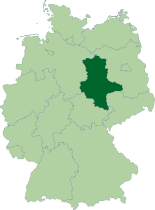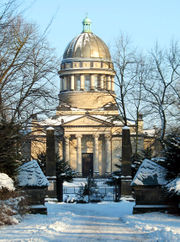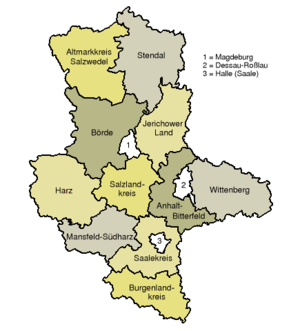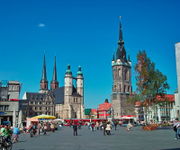Saxony-Anhalt
| Saxony-Anhalt Sachsen-Anhalt |
|||
|---|---|---|---|
| — State of Germany — | |||
|
|||
 |
|||
| Coordinates: | |||
| Country | Germany | ||
| Capital | Magdeburg | ||
| Government | |||
| - Minister-President | Wolfgang Böhmer (CDU) | ||
| - Governing parties | CDU / SPD | ||
| - Votes in Bundesrat | 4 (of 69) | ||
| Area | |||
| - Total | 20,445.26 km2 (7,894 sq mi) | ||
| Population (2009-12-31)[1] | |||
| - Total | 2,356,219 | ||
| - Density | 115.2/km2 (298.5/sq mi) | ||
| Time zone | CET (UTC+1) | ||
| - Summer (DST) | CEST (UTC+2) | ||
| ISO 3166 code | DE-ST | ||
| GDP/ Nominal | € 48 billion (2005) | ||
| NUTS Region | DEE | ||
| Website | sachsen-anhalt.de | ||
Saxony-Anhalt (German: Sachsen-Anhalt, pronounced [ˈzaksən ˈanhalt]) is a state of Germany. It has an area of 20,447 square kilometres (7,895 sq mi) and a population of 2.4 million (more than 2.8 million in 1990). Its capital is Magdeburg.
Saxony-Anhalt should not be confused with Saxony or Lower Saxony, also German states.
Contents |
Geography
Saxony-Anhalt is one of 16 states of Germany. It covers a total area of 20,445 km² (12,676 sq. miles). By size, it is the 8th largest state in Germany, and by population, the 10th largest. It borders the states of Brandenburg, Saxony, Thuringia and Lower Saxony.
The capital of Saxony-Anhalt is Magdeburg. It is the second largest city in the state, after Halle. Nearby is the city of Dessau, where the "Bauhaus" is located. The Bauhaus provided a basis for the field of architecture and fine arts in the area. Dessau is also home to the opulent Dessau-Wörlitz Garden Realm. The city’s main attraction is the Wörlitzer Park which is part of the UNESCO World Heritage Site.
The landscape of Saxony-Anhalt is quite varied. From the region of Altmark in the north, the state extends from the Magdeburg region, a vast lowland, through the Harz, a low mountain range, to Thuringia. The highest mountain in the vicinity is Brocken, with an elevation of 1,141 meters (3,735 ft). Below the summit, the National Park Harz forms an extensive wildlife sanctuary.
Administrative subdivision

From 1994 to 2003, Saxony-Anhalt was divided into 21 districts ("Landkreise"). Above this level, there were three governmental districts (Regierungsbezirke): Dessau, Halle and Magdeburg. On 1 January 2004 these three governmental districts were abolished.
A further reform, effective from July 2007, reduced the 21 districts to 11 districts (Landkreise):[2] 
- Altmarkkreis Salzwedel
- Anhalt-Bitterfeld
- Börde
- Burgenlandkreis
- Harz
- Jerichower Land
- Mansfeld-Südharz
- Saalekreis
- Salzlandkreis
- Stendal
- Wittenberg
and three urban districts (Stadtkreise):
- Dessau-Roßlau
- Halle (Saale)
- Magdeburg
History
.gif)
Saxony-Anhalt was formed as a province of Prussia in 1945, from the territories of the former Prussian Province of Saxony (except the Regierungsbezirk Erfurt), the Free State of Anhalt, the Free State of Brunswick (Calvörde and the eastern part of the former Blankenburg district) and the formerly Thuringian town Allstedt. See the respective articles for the history of the area before 1945.
When Prussia was disbanded in 1947, the province became the state Saxony-Anhalt. It became part of the German Democratic Republic (East Germany) in 1949. From 1952 to 1990 Saxony-Anhalt was divided into the East German districts of Halle and Magdeburg. In 1990, in the course of German reunification, the districts were reintegrated as a state.
Politics
List of minister presidents of Saxony-Anhalt
1945–1952
- 1945–1949: Erhard Hübener (LDPD)
- 1949–1952: Werner Bruschke (SED)
1990 to date
- 1990–1991: Gerd Gies (CDU)
- 1991–1993: Werner Münch (CDU)
- 1993–1994: Christoph Bergner (CDU)
- 1994–2002: Reinhard Höppner (SPD)
- since 2002: Wolfgang Böhmer (CDU)
26 March 2006 state election
Minister-president Wolfgang Böhmer (CDU) could not continue his coalition with the FDP and negotiated a grand coalition with the SPD instead.
| Party | Party List votes | Vote percentage | Total Seats | Seat percentage |
|---|---|---|---|---|
| Christian Democratic Union (CDU) | 326,712 | 36.2% | 40 | 41.2% |
| The Left Party (Die LINKE(PDS/WASG)) | 217,285 | 24.1% | 26 | 26.8% |
| Social Democratic Party (SPD) | 192,754 | 21.4% | 24 | 24.7% |
| Free Democratic Party (FDP) | 60,207 | 6.7% | 7 | 7.2% |
| Alliance '90/The Greens | 32,118 | 3.6% | 0 | 0.0% |
| German People's Union (DVU) | 26,894 | 3.0% | 0 | 0.0% |
| All Others | 46,235 | 5.0% | 0 | 0.0% |
| Totals | 902,205 | 100.0% | 97 | 100.0% |
Economy
Saxony-Anhalt is famous for its good soil. The "Magdeburger Börde" contains the best soil in all of Germany and some of the best of Europe. It is often said by the local populace that the smoothness of the soil is more luxurious than balls of silk. The food industry has an important role in this state. Some of the best known products are "Baumkuchen" from Salzwedel (Altmark) or "Hallorenkugeln" from Halle.
In the industrial sector the chemical industry is quite important. One of the biggest chemical producing areas can be found around the cities of Wolfen and Bitterfeld. Because of the chemical industry, Saxony-Anhalt is the largest receiver of foreign direct investments in all of eastern Germany.
Saxony-Anhalt is also the location of numerous "wind farms" throughout the state producing wind-turbine energy.
Religion
Evangelical Church in Germany 15 %[3], Catholic Church 3.5%.[4]
Anthem
- Lied für Sachsen-Anhalt ("Song for Saxony-Anhalt")
External links
References
- ↑ "Bevölkerung der Gemeinden nach Landkreisen" (in German). Statistisches Landesamt Sachsen-Anhalt. 31 December 2009. http://www.statistik.sachsen-anhalt.de/download/stat_berichte/6A102_hj_2009_02.pdf.
- ↑ District reform law 11 November 2005 (German)
- ↑ EKD http://www.ekd.de/download/kirchenmitglieder_2007.pdf
- ↑ chiesa cattolica http://www.dbk.de/imperia/md/content/kirchlichestatistik/bev-kath-l__nd-2008.pdf
|
|||||||||||||




